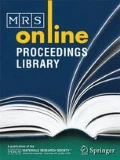Abstract
BNFL owns and operates the UK’s principal solid Low Level Radioactive Waste disposal site at Drigg in Cumbria, north west England. Drigg has been receiving waste since 1959 with approximately 900,000 m3 of waste disposed of to date. Waste accepted for disposal at Drigg comes in a variety of forms including rubble, spoil, redundant equipment, scrap and process waste, and typically contains significant metallic and cellulosic components. The organic content of the waste means that microbial activity plays a significant role in the development of the repository environment. Consequently, microbial processes are integrated into many aspects of the Drigg Post-Closure Radiological Safety Assessment (PCRSA). This begins with the identification and screening of relevant features, events and processes, through supporting research, engineering designs and finally integration into radiological safety assessment modelling. This paper outlines how and where microbiology is integrated into the Drigg PCRSA and indicates areas of active research.
Similar content being viewed by others
References
Humphreys, P. N., Kelly, E. J., Binks, P. and Howarth, D.C. Microbial Degradation Processes in Radioactive Waste Repository and in Nuclear Fuel Storage Areas. Wolfram, J. H. et al. (eds), Kluwer Academic Publishers, the Netherlands, p 217, (1997).
BNFL. Status Report on the Development of the 2002 Drigg Post-Closure Safety Case (2000).
Humphreys, P. N., McGarry, R., Trivedi, D. P., Johnstone, T., Binks, P. and Howarth, D. C. FEMS Microbiological Reviews, 20, p 557, (1997).
West, J. M., Rowe, E. J., Wealthall, G. P. and Allen, M. R. The Geomicrobiology of the Drigg Research Site. DOE Report No. DOE/RW/89/093, (1988).
Lovell, C.R. Encyclopedia of Microbiology. 2, p 55, 2nd Ed. Academic Press, (2000).
Hudson, J.A. Rock engineering systems theory and practice. Ellis Horwood: London, (1992).
R.Holmes, G.G. and Rosevear, A. Gas Generation and Release from Radioactive Waste Repositories. OECD, Paris, France, p 155, (1992).
Lovely, D. A., E. Philips, J. P., Gorby, Y. A. and Landa, E. R. Nature, 350, p 413, (1991).
Duerden, S. L., Hooper, D. P., Trivedi, D. P. and Humphreys, P. N., International Workshop on the Use of Backfill in Nuclear Waste Repositories, R&D Technical Report P178, Environment Agency and US DOE 1998, ISBN 1 873 16064 X. p 136, (1998).
Humphreys, P. N., Johnstone, T., Trivedi, D. and Hoffmann, A. Mat. Res. Soc. Proc. 353, Pt 1, p 211, (1995).
Manton, S., Johnstone, T., Trivedi, D., Hoffmann, A. and Humphreys, P. N. Radiochemica Acta, 68, p 75, (1995).
Stumm, W. and Morgan, J. J. Aquatic Chemistry. 2nd Ed.Wiley, New York, (1981).
Parkhurst, D. L., Thorsteson, D.C. and Plummer, L. N. PHREEQE - A computer program for geochemical calculations, USGS, USA, (1980).
Small, J. S., Humphreys, P. N., Johnstone, T. L., Plant, R., Randall, M. G. and Trivedi, D. P. Mat. Res. Soc. Proc, 608, p 129, (2000).
Author information
Authors and Affiliations
Rights and permissions
About this article
Cite this article
Beadle, I., Humphreys, P.N., Pettit, C. et al. Integrating Microbiology into the Drigg Post-Closure Radiological Safety Assessment. MRS Online Proceedings Library 663, 665 (2000). https://doi.org/10.1557/PROC-663-665
Published:
DOI: https://doi.org/10.1557/PROC-663-665




